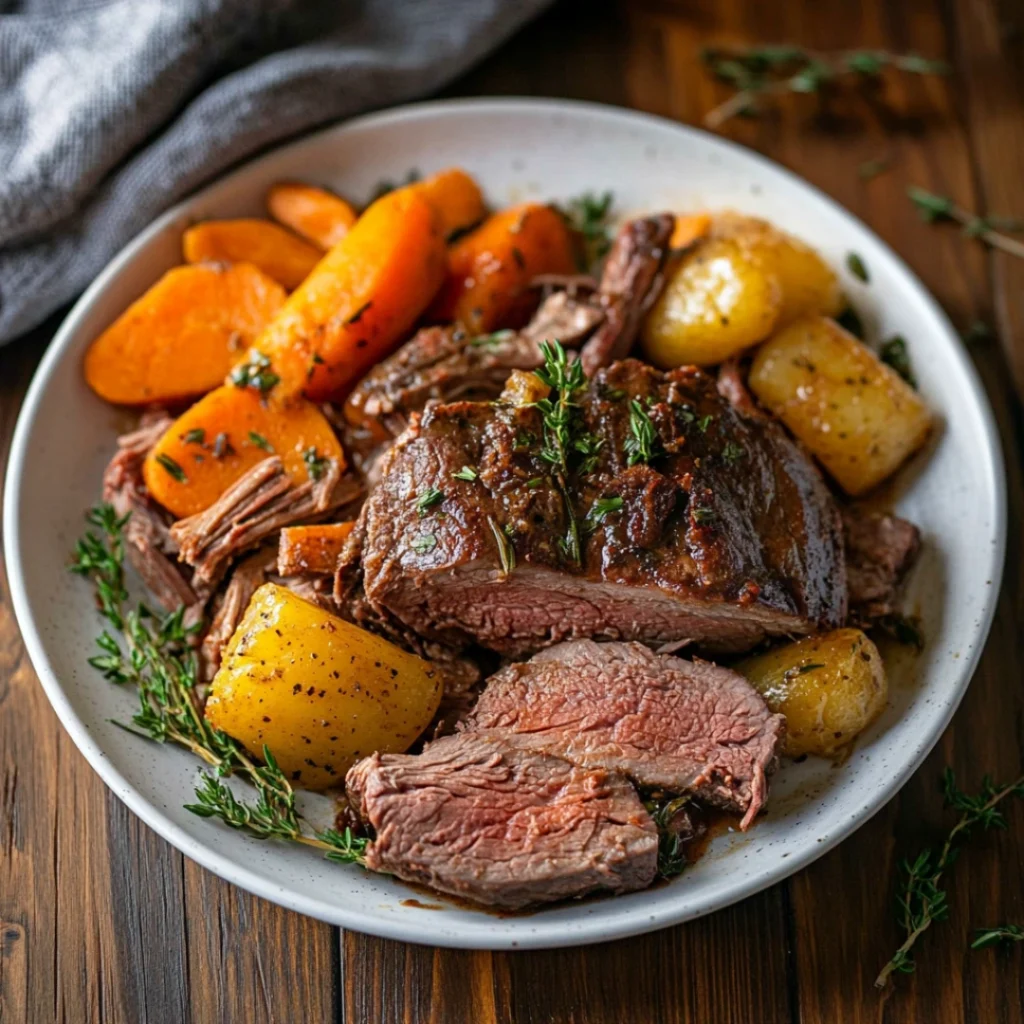
Raise your hand if you’ve ever stared into the fridge at 5 p.m., wondering what on earth you’re going to make for dinner. Yep, same here. That’s why I swear by this Chuck Roast Recipe when life gets hectic or when I need a hearty, comforting dinner to bring everyone to the table, without having to pull a culinary rabbit out of a hat.
This isn’t just any beef roast. It’s a fall-apart-tender, flavor-soaked, vegetable-cuddled hug on a plate. And whether you opt for the slow cooker chuck roast method or go full-on old school with an oven-braised chuck roast, I promise this dish will be the highlight of your week.
Table of Contents
Why You’ll Love This Chuck Roast Recipe
- Minimal Effort, Maximum Flavor: A bit of seasoning, a quick sear, and you’re halfway done.
- Flexible Cooking Methods: Whether you’re a Crockpot queen or a Dutch oven devotee, this recipe works for you.
- Built-In Side Dish: With carrots, potatoes, and celery cooking right alongside, dinner makes itself.
- Hearty and Homey: This is the very definition of comfort food dinner—warm, savory, and deeply satisfying.
Ingredients
For the Roast:
- 3–4 lb chuck roast (well-marbled is key)
- 2 tbsp olive oil
- Salt and black pepper to taste
- 1 tbsp garlic powder
- 1 tbsp onion powder
- 1 tsp dried thyme
- 1 tsp smoked paprika
For the Vegetables & Sauce:
- 1 large onion, sliced
- 4 cloves garlic, minced
- 4 carrots, peeled and cut into chunks
- 3 celery stalks, chopped
- 1 lb baby potatoes, halved
- 2 cups beef broth (low sodium preferred)
- 1 tbsp Worcestershire sauce
- 2 tbsp tomato paste
- 1 tbsp cornstarch + 2 tbsp water (optional, for thickening)
Step-by-Step Instructions
1. Prep the Chuck Roast
Grab that glorious hunk of chuck roast and give it a good pat down with paper towels. This helps get that perfect sear.
Sprinkle on salt, pepper, garlic powder, onion powder, thyme, and smoked paprika. Rub it in like you’re giving it a mini spa treatment.
2. Sear the Meat
Heat the olive oil in a skillet over medium-high heat. Once shimmering, sear the roast on all sides until you get that golden-brown crust—about 4–5 minutes per side.
This step is what gives that deep, rich flavor you crave in a tender beef roast. Totally worth the extra few minutes!
3. Layer the Vegetables
In your slow cooker or Dutch oven, toss in the onions, garlic, carrots, celery, and potatoes. This makes a comfy little bed for your roast to rest on.
4. Build the Sauce
Mix together the beef broth, Worcestershire sauce, and tomato paste in a bowl. Pour it evenly over the veggies.
5. Cook the Roast
Slow Cooker Method: Lay the seared roast gently on top of the veggies. Cover and set your slow cooker to LOW for 8–9 hours or HIGH for 4–5.
Oven-Braised Method: Preheat your oven to 325°F (163°C). Nestle the roast atop the veggies in a Dutch oven, cover tightly, and roast for 3.5 to 4 hours.
Either way, you’re looking for a roast that practically melts under your fork.
6. Optional: Thicken the Sauce
Remove the roast and vegetables. Combine the cornstarch and water, stir it into the cooking liquid, and let it simmer on the stove for 5–10 minutes. Boom: instant gravy.
7. Serve and Enjoy
Slice or shred your roast, pile those veggies high, and drizzle everything with that gorgeous sauce. Bonus points if you serve it with crusty bread or a scoop of mashed potatoes.
Real-Life Chuck Roast Moments
This Sunday roast recipe holds a nostalgic place in my heart. It was the first “grown-up” dinner I made after moving into my first apartment. I’d just bought a slow cooker and wanted to prove I could cook something more ambitious than boxed mac and cheese. Spoiler: it worked—and I felt like a domestic goddess.
Now, it’s my go-to for everything from family dinners to meal prepping for the week. Even my picky eaters ask for seconds!
Cooking Tips & Tricks
- Go Low and Slow: For the most melt-in-your-mouth texture, the low setting on your slow cooker is magic.
- Use Fresh Herbs: Got fresh thyme or rosemary on hand? Toss it in! It adds a lovely brightness.
- Make It a Freezer Meal: Assemble everything in a freezer bag, freeze flat, and then thaw overnight before cooking.
- Don’t Rush the Sear: That golden crust on your beef isn’t just for looks—it builds irresistible depth of flavor.
FAQs About Chuck Roast Recipes
Can I make this ahead of time? Yes! The flavors deepen overnight. Store in an airtight container for up to 4 days or freeze for up to 3 months.
Can I use other veggies? Totally. Parsnips, sweet potatoes, and mushrooms are all great add-ins for your chuck roast with vegetables.
What if I don’t have Worcestershire sauce? A splash of soy sauce and a dash of balsamic vinegar make a fine substitute.
How do I make this a low-carb version? Skip the potatoes and swap carrots for lower-carb veggies like cauliflower or green beans.
More Recipes You’ll Love
Check Which cooking method is best for a chuck roast? and Dirty Rice Recipe.
Whether you’re battling midweek chaos or planning a relaxing weekend dinner, this Chuck Roast Recipe delivers every time. It checks all the boxes: easy, satisfying, and utterly delicious. So go ahead—light that candle, pour yourself a glass of wine, and let dinner cook itself.
You deserve it.
